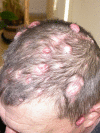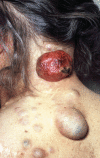Brooke-Spiegler Syndrome and Phenotypic Variants: An Update
- PMID: 26971504
- PMCID: PMC4838966
- DOI: 10.1007/s12105-016-0705-x
Brooke-Spiegler Syndrome and Phenotypic Variants: An Update
Abstract
Brooke-Spiegler syndrome (BSS) is an inherited autosomal dominant disease characterized by the development of multiple adnexal cutaneous neoplasms most commonly spiradenoma, cylindroma, spiradenocylindroma, and trichoepithelioma. Multiple familial trichoepithelioma (MFT) is a phenotypic variant of the disease characterized by the development of numerous trichoepitheliomas (cribriform trichoblastoma) only. Malignant tumors arise in association with preexisting benign cutaneous neoplasms in about 5-10% of the patients . Apart from the skin, major and minor salivary glands have been rarely involved in BSS patients. Extremely rare is the occurrence of breast tumors (cylindroma). The gene implicated in the pathogenesis of the disease is the CYLD gene, a tumor suppressor gene located on chromosome 16q12-q13. Germline CYLD mutations are detected in about 80-85% of patients with the classical BSS phenotype and in about 40-50% of the individuals with the MFT phenotype using a PCR based approach with analysis of exonic sequences and exon-intron junctions of the CYLD gene. There appears to be no genotype-phenotype correlations with respect to the severity of the disease, the possibility of malignant transformation, and development of extracutaneous lesions.
Keywords: Brooke-Spiegler syndrome; CYLD gene; Cylindroma; Spiradenoma; Trichoepithelioma.
Figures








Similar articles
-
Novel and recurrent germline and somatic mutations in a cohort of 67 patients from 48 families with Brooke-Spiegler syndrome including the phenotypic variant of multiple familial trichoepitheliomas and correlation with the histopathologic findings in 379 biopsy specimens.Am J Dermatopathol. 2013 Feb;35(1):34-44. doi: 10.1097/DAD.0b013e31824e7658. Am J Dermatopathol. 2013. PMID: 23249834
-
Large germline deletions of the CYLD gene in patients with Brooke-Spiegler syndrome and multiple familial trichoepithelioma.Am J Dermatopathol. 2014 Nov;36(11):868-74. doi: 10.1097/DAD.0000000000000068. Am J Dermatopathol. 2014. PMID: 25347032
-
A clinicopathologic and molecular biologic study of patients presenting with few adnexal tumors (two to four) from the morphological spectrum of Brooke-Spiegler syndrome.Am J Dermatopathol. 2013 Feb;35(1):19-24. doi: 10.1097/DAD.0b013e318255dd37. Am J Dermatopathol. 2013. PMID: 22588548
-
Phenotype-genotype correlations for clinical variants caused by CYLD mutations.Eur J Med Genet. 2015 May;58(5):271-8. doi: 10.1016/j.ejmg.2015.02.010. Epub 2015 Mar 14. Eur J Med Genet. 2015. PMID: 25782638 Review.
-
Understanding Inherited Cylindromas: Clinical Implications of Gene Discovery.Dermatol Clin. 2017 Jan;35(1):61-71. doi: 10.1016/j.det.2016.08.002. Dermatol Clin. 2017. PMID: 27890238 Review.
Cited by
-
Association of Membranous Basal Cell Adenoma and Basal Cell Adenocarcinoma With Brooke-Spiegler Syndrome.Cureus. 2024 Sep 6;16(9):e68819. doi: 10.7759/cureus.68819. eCollection 2024 Sep. Cureus. 2024. PMID: 39376856 Free PMC article.
-
Giant Mushroom-Like Cutaneous Cylindroma of the Head.Open Access Maced J Med Sci. 2018 Sep 25;6(10):1868-1870. doi: 10.3889/oamjms.2018.401. eCollection 2018 Oct 25. Open Access Maced J Med Sci. 2018. PMID: 30455764 Free PMC article.
-
[Syndroms associated with benign skin tumors].Hautarzt. 2022 Feb;73(2):114-126. doi: 10.1007/s00105-022-04947-0. Epub 2022 Jan 25. Hautarzt. 2022. PMID: 35076726 Review. German.
-
Treatment of Brooke-Spiegler Syndrome Trichoepitheliomas with Erbium: Yttrium-Aluminum-Garnet Laser: A Case Report and Review of the Literature.J Clin Aesthet Dermatol. 2020 Jul;13(7):41-44. Epub 2020 Jul 1. J Clin Aesthet Dermatol. 2020. PMID: 32983336 Free PMC article.
-
Multiple Trichoepithelioma Syndrome: A Case Report.Cureus. 2023 Aug 4;15(8):e42930. doi: 10.7759/cureus.42930. eCollection 2023 Aug. Cureus. 2023. PMID: 37667697 Free PMC article.
References
Publication types
MeSH terms
Substances
Supplementary concepts
LinkOut - more resources
Full Text Sources
Other Literature Sources
Medical

